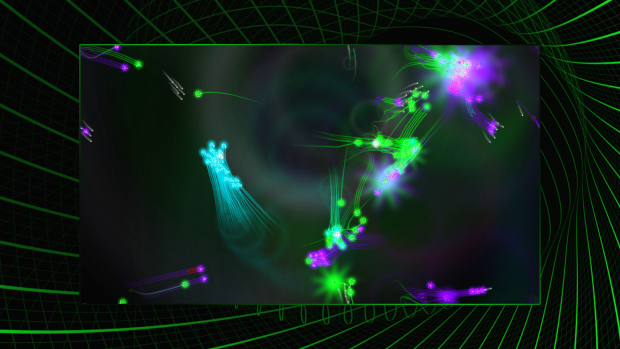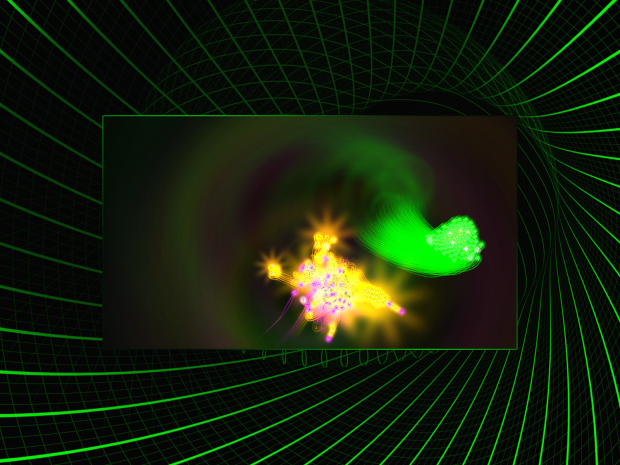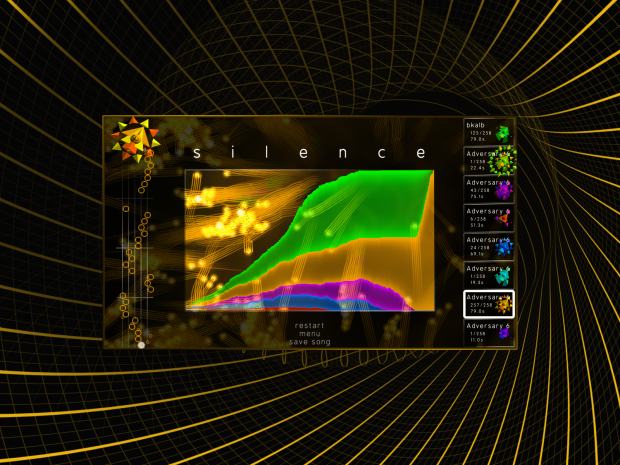When preparing the postmortem for Influence, we chose to focus on the design decisions, rather than the production details, for two reasons. First, we felt it would be more interesting, that audiences would care more about why we added or cut specific features than that we bickered for weeks over the names of the game modes. Second, we felt it would be more useful. Hopefully, everyone already knows that good time management is important, but they may not pay as much attention to their design process, or may not have looked at it in the way we now look at ours.
To view the slide show presentation of this postmortem, including new videos from the early development versions of Influence, as seen in the MineCon Indie Developer Theater, go to Blanketfortgames.com
What Went Right
Music
One of the features of Influence we are most pleased with is the music. The design of the music went through a number of iterations, each improving on the last. Our first effort to make the game not silent was to put a popping sound in whenever an id was overtaken. The pops succeeded at making noise, but were unrelated to anything else in the game.
Our next iteration replaced the pops with steady tones. Each color was assigned a frequency around which their tone was based. The tone’s volume was bumped whenever an id was overtaken, so there was still an audible clue signaling game events, but the tones also reflected the state of the game. Louder tones indicated that the associated color controlled more ids, so players could tell if they were winning based on the sounds in the game. The tones were an improvement over the pops, but they still felt out of place.
Our final musical design iteration has each color represented by an instrument. Overtaking an id causes your instrument to play an additional note in its loop. The instruments’ volumes are still modulated by the current number of controlled ids, but now the music reflects the history of the game as well (if you hear a bunch of really quiet guitar notes, you know that red took a lot of ids at one time, but has since lost most of them).
By customizing your adversaries’ color in single player, or playing a multiplayer game with like-minded folks, you can select the instruments by coordinating colors, and use Influence to make your own music. As we iterated on the music design, the music was increasingly tied to gameplay, and felt like a more organic part of the game.
Multiplayer
Multiplayer in Influence is another example of the design fitting well with the game concept. Multiplayer was a feature we knew we wanted from the very beginning, which meant that every time we added anything to single player, we also added it to multiplayer, keeping both game types in sync. This was important because multiplayer was, for us, the most fun way to play the game, and resulted in a lot of yelling around the office during playtest sessions. It was also a boon to beta testing, as our testers played more and found more bugs because of the presence of multiplayer. It is safe to say that without multiplayer, there would be no Influence.
Id Shape
Another part of Influence’s design that evolved in an interesting way is the shape of the ids. In the beginning, they were simple arrowheads. The arrowheads showed the direction of the ids and their color, but they were all identical, and we wanted to differentiate the ids from one another. We tried to design a set of unique shapes, with each shape differentiable by silhouette, but players had to memorize which one was the fast one, which one was the agile one, and so on. The shapes gave no clue about the abilities of the ids. Also, while the unique shapes were differentiable individually, when a group clumped together, it was very difficult to determine its composition. We gave the different shapes different trails in an attempt to alleviate the clumping problem, but that just made it noisier. We finally solved the id shape problem by integrating the shape of the id with its performance in the game, so that its attributes define its shape. More agile ids have bigger, more complex cores, resistant ids have more and bigger rings around them, and faster ids have more and longer trails.
Aesthetic
The final Influence design success that we would like to highlight is the overall aesthetic, particularly the background of the game. The flat black background we started with was dull and uninteresting, so we attempted to come up with a way to break it up.
Our first solution was to have nearly-transparent squares that expanded and rotated, creating interesting patterns when they overlapped. The squares did their job, and looked neat, but were completely detached from the rest of the design. We began to integrate the background and the game by changing the squares to circles, because we used circles elsewhere in the art, but this didn’t look as cool, and was only very marginally more related to the game.
Next, we tried coloring the background circles based on the colors of the ids in an active game. Unfortunately, the coloration was too subtle to be effective, and just made the background look muddled. It wasn’t until we had the rings follow the ids that were coloring them that the background became an integrated part of gameplay. Not only does this reflect the game (you can see an opposing flock coming because of the rings they generate), but players can affect the background, creating interesting and beautiful patterns.
What Went Wrong
Allegiances
In Influence, players are required to choose an allegiance in order to play the game. Your allegiance represents the cause you champion as you play the game, the reason you are vying for dominance. Your allegiance is the purpose behind your idea. Your allegiance has no gameplay effect whatsoever. It does not change the way your ids move, act, or interact. Allegiances are so separated from gameplay that they are barely even displayed (only as a small symbol on the core of the id, which can only be made out at maximum zoom). Additionally, allegiances have a lot of text associated with them, all of which is meaningless to gameplay. If we were still working on Influence, allegiances would be removed.
Global Metagame
Related to allegiances was the global metagame. The idea was that there would be a map on the Influence website, divided into territories, and each territory would be controlled by an allegiance. Then, as players competed in multiplayer games, winners would advance their allegiance’s holdings and territory on the map. The global metagame, like allegiances, had no gameplay effect. The metagame wasn’t even part of the game (we could build and play the game without ever working on it), so we continuously pushed it back in the schedule, until eventually it fell off the end, and didn’t get made. We took the fact that we could make a fun, playable game without ever touching the global metagame as a sign that the global metagame didn’t need to exist.
Single Player Campaign
Easily our biggest design error was the single player campaign. We were working with a publisher for a time, who told us that in order to be viable, Influence needed a certain number of hours of single-player content. We took those hours, divided by our approximation of five minutes per game, and came up with eighty-three single player levels that we needed to create. Naturally, we didn’t want to simply ask players to play the same game eighty-three times, so we created a bunch of extra things to add some sort of progression to these levels. We added obstacles on the play field, several alternate goals and victory conditions, even triggers that changed the game midway through. Eventually we parted ways with the publisher, and, after spending far too much time trying to integrate the single player campaign with the rest of the game, and failing, we gave up and got rid of the single player campaign altogether. The single player campaign was never able to escape the feeling of being tacked on, and never fit with the feel of the core single and multiplayer experience.
Core Vision
The final design misstep we would like to address isn’t really a game feature. The core vision for Influence, the spreading of ideas, was not something we established early on in the development process. Influence began as a prototype of a game mechanic, and didn’t define a vision until very late in the process. We didn’t even have a design document for Influence until five months into development, and when we created one, it was more a description of the prototype we had created than it was a blueprint for what we wanted to create. Our lack of focus led to several difficulties.
First, it was difficult to talk about the game to press, other developers, and even family members. All we could do was to describe the prototype, or show it, and say ‘this is our game.’
Second, there was a lack of concept art, because we had no clear direction to give to the artists. Our concept art during development consisted solely of screenshots of the prototype.
Third, our demos lacked focus. Not knowing what we wanted to showcase meant our demos were simply releases of the prototype; whatever we had completed at the moment was our demo.
We finally sat down and talked about what Influence meant to each of us. We realized we were modeling the spread of ideas, and we were finally able to pitch the game in a way that people could understand.
Conclusion
One design lesson has become clear over the course of developing Influence. The need for a clear core design, whether a doc, a pitch, or an idea, is paramount. Everyone on the team needs to share a clear vision of what game is being made, and have a blueprint to refer to. We now see the game design as a circle, containing all things that are the game, and nothing that is not. Once that circle is defined, the task is clear: add things to the game until the circle is full, and then remove everything that lies outside. This lesson applies to all facets of the game. Art, music, controls, and game mechanics – everything works better when it is aligned to the core design.








Very interesting - thanks for sharing your thoughts and experiences! Although there is a lot i already know there is a lot more now to think about too. A good project grows best with a strong vision keeper...